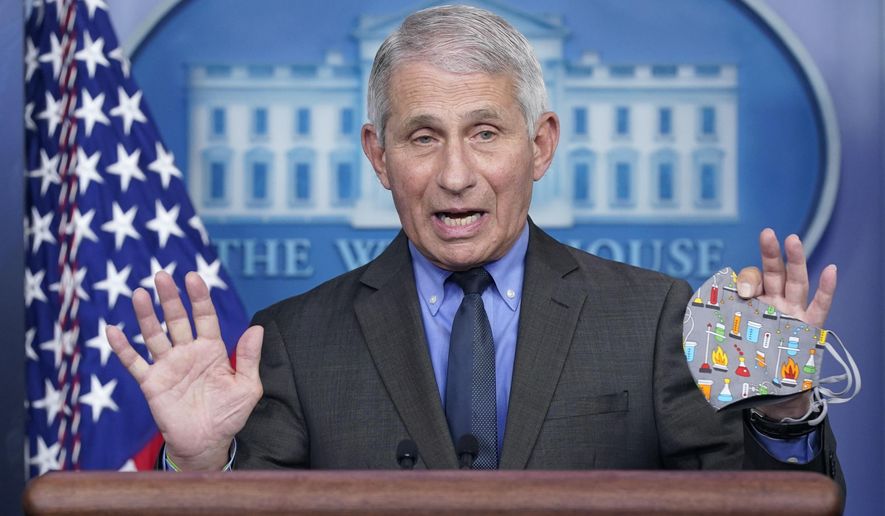OPINION:
Don’t wear a mask. Wait, wear a mask. Better, wear two masks.
Wash your hands a lot. Disinfect everything nonstop. Wait, never mind.
Six-foot social distancing is science. Hang on, maybe not.
More than a year into the COVID-19 pandemic, it’s remarkable how little we know about the coronavirus. And the message keeps changing, which makes you wonder whether anyone really knows anything at all.
Remember when a doctor — early in the pandemic — put out a viral video telling Americans they just needed to wash their hands a lot to keep from catching or spreading COVID? The Centers for Disease Control and Prevention (CDC) jumped on board, as did the World Health Organization (WHO).
But that turned out to be not at all true.
Just last week, the CDC put out new guidance. “It is possible for people to be infected through contact with contaminated surfaces or objects (fomites), but the risk is generally considered to be low,” the guidance says. The CDC added that the chance of contracting the coronavirus through surface transmission is lower than 1 in 10,000.
Those are some pretty slim odds.
While the WHO in March 2020 asserted the coronavirus was not airborne but instead transmitted mostly through “respiratory droplets and contact routes” — picked up by touch — that turned out to be all wrong.
Still, every place you go nowadays, someone is wiping down this or disinfecting that. Somehow, a writer at the Atlantic magazine knew it was all phony way back in July, writing a piece headlined, “Hygiene Theater Is a Huge Waste of Time.”
“The fact that surface areas — or ‘fomites,’ in medical jargon — are less likely to convey the virus might seem counterintuitive to people who have internalized certain notions of grimy germs, or who read many news articles in March about the danger of COVID-19-contaminated food,” wrote Derek Thompson. “Backing up those scary stories were several U.S. studies that found that COVID-19 particles could survive on surfaces for many hours and even days.”
Ah, “studies.”
Then there were the masks.
Back in March 2020, when the WHO was telling everyone it was mostly surface transmission, Dr. Anthony Fauci, the country’s top infectious disease expert, declared, “There’s no reason to be walking around with a mask.”
“When you’re in the middle of an outbreak, wearing a mask might make people feel a little bit better and it might even block a droplet, but it’s not providing the perfect protection that people think that it is,” the doctor said on CBS News.
In February, Dr. Fauci, the director of the National Institute of Allergy and Infectious Diseases who served on former President Trump’s White House Coronavirus Task Force and is now President Biden’s chief medical adviser on COVID-19, said that wearing two masks is likely more effective than wearing one.
“If you have a physical covering with one layer, you put another layer on it, just makes common sense that it likely would be more effective,” Dr. Fauci told NBC News.
Then there’s former Food and Drug Administration Commissioner Scott Gottlieb, who said last month that the six-foot social distancing mandate put in place across much of the U.S. “wasn’t based on clear science.”
“This six-foot distancing requirement has probably been the single costliest mitigation tactic that we’ve employed in response to COVID … and it really wasn’t based on clear science … We should have re-adjudicated this much earlier,” he said in an interview with CNBC.
We’ll have to wait a while to see whether any of that advice pans out.
There’s no question that getting a grasp of an emerging virus is a tough task. While scientists know about coronaviruses, they’d never seen one quite like this.
But that begs the question as to why so many people were declaring so many things — without knowing.
Social media has played a big role in the spread of misinformation. A recent study led by McGill University showed that Canadians who use social media “are more likely to consume this misinformation, embrace false beliefs about COVID-19, and subsequently spread them,” McGill wrote.
“Not only do their algorithms saturate information streams with American news, they also propagate false news much faster than factual news. By privileging content that draws emotional responses from users, the algorithms help spread misinformation like wildfire,” McGill wrote.
But here’s the real problem: America’s media. The old adage of “if it bleeds, it leads” is as true today as ever.
U.S. news media has cashed in on scaring the bejeebers out of Americans, often by focusing on marginal stories to push an agenda.
Last month, the CEO of CNN’s parent company said the COVID-19 pandemic has been “really good for ratings,” adding that wall-to-wall coverage won’t be ending soon.
“It turns out the pandemic is a pretty big part of the news cycle and that’s not going away any time soon,” WarnerMedia CEO Jason Kilar said. “It turns out it’s really good for ratings.”
Ratings over facts. Sounds about right in 2021.
• Joseph Curl covered the White House and politics for a decade for The Washington Times. He can be reached at jcurl@washingtontimes.com and on Twitter @josephcurl.




Please read our comment policy before commenting.